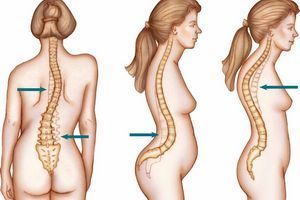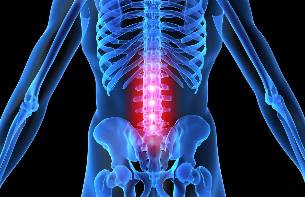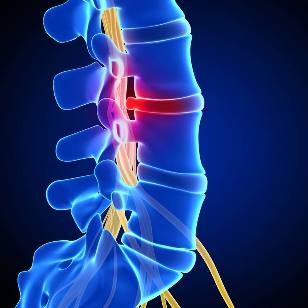The most common type of pathology of the spine – lumbar osteochondrosis. The largest percentage of people affected from lumbar degenerative disc disease gets to the age period after 30 years. The disease is caused by degeneration of the cartilage of the spine and intervertebral discs. The disease is characterized by severe pain attacks in the department of the loins.

The reasons for lumbar degenerative disc disease
The reasons why this disease obtained, most commonly, include the following:
- a small intensity physical activity;
- diseases of the thyroid gland, cardiovascular system, GIT;
- high physical burden, weight lifting;
- diseases of the vertebral joints, in particular rheumatoid arthritis
- the vertebrae of backwardness;
- flat feet ;
- vertebrate injury, and in particular attributable to the lumbar and sacral department;
- not the right metabolism;
- degeneration of the spine associated with aging.
At the risk of the disease of the lumbar osteochondrosis are people who:
- they have curvature of the spine;
- suffer from obesity, a disorder of the perception of the metabolism;
- long are in a bent position;
- have a genetic predisposition;
- they are in an environment of increased stress;
- they have disturbed sleep, a little rest;
- expose the body hypothermia;
- they are the representatives of such professions like movers, construction workers, drivers, but also have special, related to the constant search for at the computer.
Symptoms of lumbar degenerative disc disease
In addition to the pain experienced by the sick osteochondrosis of the lumbar, especially in the period of strong load, also distinguish between other symptoms of this disease, which manifest themselves in the following:
- a dull pain passes from the hearth of inflammation in the leg;
- strengthening of the pain syndrome when lifting heavy, you change the position of your body, cough, sneezing;
- during a long stay in one position, blood accumulates in the heart, and at the slightest attempt to change the posture of your body, there is a sharp pain;
- the constant tension of the back muscles;
- cross the lumbar at the slightest hypothermia;
- numbness of thigh, gluteal muscles, legs and feet;
- tingling feeling in the legs;
- blood cramp up to the extent of the lack of heart rate;
- pathology of sweat glands;
- drying out of the skin in the area of the hearth pain and disorders of sensitivity.

The main symptoms of lumbar degenerative disc disease in women
Osteochondrosis of the lumbar spine – a common disease characterized by the dmd of the intervertebral discs. With the passage of time, and also from the excessive load is gradually coalesce, are flat. It is fraught with limitations of mobility and emergence of unpleasant feelings due to samishisa of the vertebrae, which exert pressure on the nerve roots and blood vessels. Recognize the symptoms of lumbar degenerative disc disease in women and the symptoms is possible by using the proposed challenges.
Lumbar osteochondrosis — causes, treatment, diagnosis
The lumbar department – it is part of the spine, which accounts for the maximum load when jumping, running, walking, sitting, exercise, force sports and in other situations. The lumbar department consists of five vertebrae, located between the sacrum and separation of the thoracic spine. When injury to the lumbar, when the large load on the spine going the deformation of the intervertebral discs, the destruction of the fibrous rings support the intervertebral disc, biochemical change in the cartilage, violation of blood circulation. When rupture of the fibrous rings are going on a protrusion of the intervertebral discs, the development of intervertebral hernia.

Osteochondrosis of the lumbar – it's a hard condition, accompanied by pain, that spreads in the legs, pain in the lower part of the back, the development of complications. In the neurological department Usupovskiy the hospital, the patient may obtain the advice of an experienced doctor-a neurologist, to undergo a diagnostic, find out the cause of the development of the disease to get effective treatment and go through rehabilitation. The department of neurology, engaged in treatment of autoimmune disorders, disorders of cerebral circulation, chronic pain, consequences of craniocerebral injuries, age-related diseases.
Osteochondrosis of the lumbar: symptoms
The main symptom in osteochondrosis are pain. The patient quickly tired, he often headache, troubled by poor sleep, increased irritability. In the development of the disease there are the negative symptoms from the urinary system, increases the sensitivity of the feet, the skin on the extremities becomes dry, often occur muscle cramps, pain in a fit of impaired sweating.
Osteochondrosis of the lumbar characterized by deformation of the intervertebral disc, changes in their shape, duchenne muscular dystrophy, the bias, the coracoid overgrowth of the vertebrae. In the development of degenerative disc disease of the lumbar is the loss of flexibility of the spine, irritated niinivaarantie nerve endings, sacral nerve endings that form the sciatic nerve. Develops complications — sciatica. The reason for the development, without becoming: squeezing the nerve root in the lumbar spine, the deformation of the intervertebral discs, their shift, the coracoid overgrowth of the vertebrae, meziobratlovci hernia. Sciatica is accompanied by severe pain, reduced quality of life of the patient.

In the development of lumbar degenerative disc disease, the following syndromes:
- painful.
- root syndrome.
- ischemic syndrome.
- vertebral syndrome
Expert opinion
According to a number of income to doctors degenerative-degenerative diseases of the spine occupy the first place. According to statistics, in 60-80 % of cases of aggravation of degenerative disc disease sees to the development of temporary incapacity for work. In the structure of the disability on the proportion of degenerative-degenerative diseases account for 20 % of cases. Lumbar osteochondrosis — the most common localization of the faulty process. Doctors confirm that the proportion of this disease accounts for 60-70 % of cases.
Diagnosis of pathology in the hospital is done by using the x-ray studies, MRI and CT. Osteochondrosis is dangerous complications. In severe cases forfeit the ability to caiqu self-service. Therefore, it is important to timely visit a doctor to conduct a survey and determine the correct treatment. Depending on the degree of degenerative-degenerative process in the lumbar vertebrae of the doctors of the hospital to develop an individual therapeutic plan. This includes the means of causal, pathogenetic and symptomatic therapy. In addition, the treatment plan contains recommendations for the prevention of recurrence of the disease.
Osteochondrosis of the lumbar spine: treatment
Treatment of degenerative disc disease of the lumbar depend on the neglect of the disease. In osteochondrosis of the issue several degrees of development of the pathology:

- light the degree of development of the disease – the fibrous ring around the intervertebral disc has a crack, which are filled with the content of the gelatinous core. Discs at this stage of the development of the disease deformed, weakly, fear, pain, which can be considered a pain in the heart. The pain occurs in the lower part of the back when lifting heavy weights and sharp operation. The pain can be stable helena sharp, sudden.
- the process of deformation of the intervertebral discs continues. Happening a pinched nerve endings, reduces the interval between each vertebra, appear more pronounced discomfort in the lumbar, often arise pain bouts with the unpleasant feelings in the lumbar and sacral.
- the third stage of development of lumbar degenerative disc disease is characterized by the rupture of the fibrous rings around the intervertebral disc, occurs squeezing gelatinous core, squeezing the nerve roots and blood vessels – developing intervertebral hernia. The patient in such a phase in the development of the disease suffer from a violation of the functioning of the internal organs, it becomes slouching.
- the fourth degree of the disease – severe stage of the disease. Occurs, the deformation of the spine that leads to disability.
The heavy degree of the disease often requires surgical treatment due to the final deformation of the spine. The spine is deformed bone growths, in patients disturbed motor activity. In women and men the progression of the disease sees to disturbances in the functioning of the genitourinary system: in men, impaired potency, in women during pregnancy arises from the deformation of the intervertebral discs, suffering internal sexual organs.
Vascular-ischemia compression
Violation of the blood supply to the spinal cord and other peripheral structures see the "dilution" of the structure of the intervertebral discs, and thus the abnormal mobility of the spine, education osteophytes and neoarthrosis.
Compression myelopathy

Narrowing of the spinal canal, causing periodic paroxysmal weakness in the limbs, pain in the "cross" syndrome of the lumbar with the impact on the back of the thighs. In this context, develops malnutrition/hypotension calf/gluteal muscles, the extinction of plantar, anal and Achilles reflexes, paresis of the foot.
Treatment of lumbar degenerative disc disease
Treat the disease can and must. Naturally, in this case, only help the complex therapy, which focuses on reducing the symptomatology of autoimmune disease, restore the structure of the spine and prevention of recurrence of problems.
Complex therapy of the above diseases includes:
- The intake of the drug funds.
- The siege of the injection.
- Gymnastics and movement therapy.
- Massage and manual therapy.
- Physiotherapy.
Medications in the lumbar osteochondrosis

- Of the anesthetic.
- Revitalizing chondroprotectors.
- Vitamins. Optimum — group B.
- Injection. Anesthetic, reducing agents, cartilage and normalizers of microcirculation of blood.
- The local resources.
Gymnastics in osteochondrosis of the lumbar spine
An important element of the recovery of the spine. All treatments are designed individually, focus on the removal of pain syndrome and spasm of the muscle, normalization of blood circulation in the blood, the resumption of work of the intervertebral discs.
Massage in osteochondrosis of the lumbar
Massage — an obligatory component of complex therapy of the disease. It helps to relax and train the muscles of the lower part of the back, which raises the process of recovery of the cartilage, relieves pain. Most often when the above disease is used treatment, spot, hardware, cupping-vacuum and connection-woven massage.
Physiotherapy
As usual, physiotherapy called sick osteochondrosis of the lumbar spine only in remission of the disease, after overcoming the period of exacerbation of the problem. Modern and classical methodologies:

- Acupuncture. The impact of special needles to acupuncture points on the back.
- Sprain. The classic technique of traction of the spine on massage, traction couch, carried out by a qualified manual therapist.
- Electrophoresis. Known from 60-ies, a comprehensive non-operative method is the impact on the external problem the affected places.
- Traction decompression. Automated hardware-stretching the spine on a special medical complex.
- Shock-wave therapy. The use of infrasound waves for the treatment of degenerative disc disease.
- Osteopathy. A comprehensive methodology, combining elements of chiropractic, massage and therapeutic rehabilitation.
- Magnetopuncture. The direct impact of variable magnetic field on the spine.
- Laser puncture. The processing of the pressure points induced by beam radiation.
- Electro-stimulation. The use of small variable currents on the affected places.
Prevention of lumbar degenerative disc disease
After completing the comprehensive treatment and physiotherapy, the longer the period of time necessary supportive therapy: in this period the spine is still weak and requires support. In addition, prevention is for preventing the occurrence of degenerative disc disease of the lumbar. The main activity is:
- Regular balancing exercises, preferably under the supervision of a qualified podiatrist.
- Normalization of body weight: quite often an aggravating factor that affects the emergence of degenerative disc disease, is obese persons.
- Correction of the diet. In the regular diet should include foods rich in such elements as calcium and magnesium. In this case you should exclude too fatty and unhealthy food, but other food, not falling under the definition of healthy foods.
- Refusal of bad habits. Alcohol and smoking increase the destruction of all the processes in the body, it applies to the emergence of degenerative disc disease.
- The right posture of your body. Definitely attention to your possession of your body, especially if you do not exceed your work is connected with constant finding in computer helena other employee activities. Also watch out for do not exceed your child — how and how long it sits. It is a normal, proper posture of your body will allow you to draw attention to the emergence of scoliosis and therefore further degenerative disc disease.
- The use of proper footwear, clothing and accessories, refraining from regular wear weights. Improper footwear, hard bitch on the shoulder, the work of the loader — all of these factors sometimes have decisive influence on the beginning of the creation of the destructive processes in the spine.

































